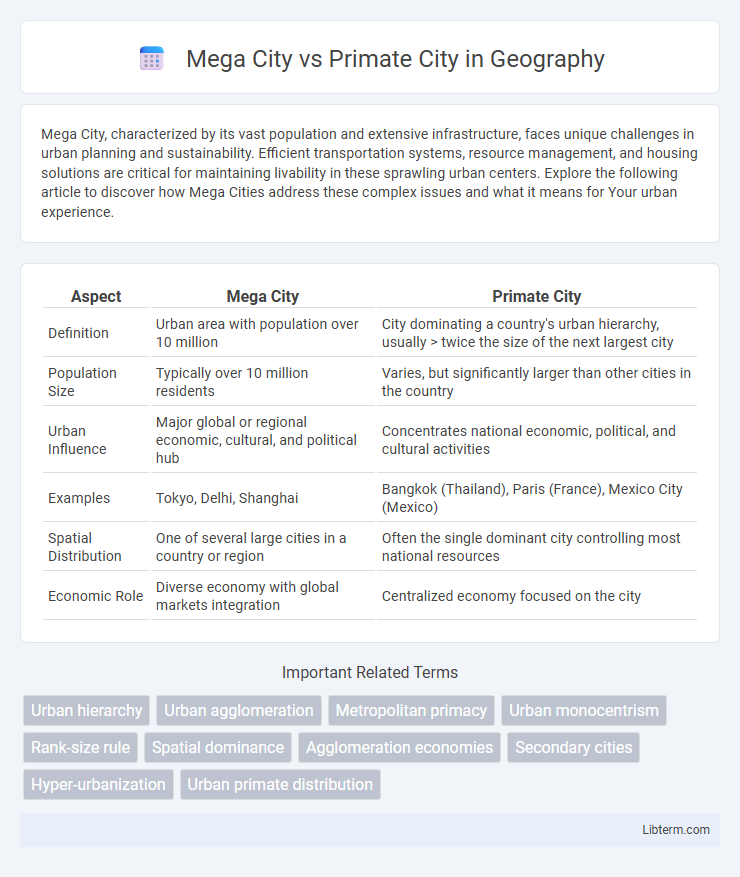Mega City, characterized by its vast population and extensive infrastructure, faces unique challenges in urban planning and sustainability. Efficient transportation systems, resource management, and housing solutions are critical for maintaining livability in these sprawling urban centers. Explore the following article to discover how Mega Cities address these complex issues and what it means for Your urban experience.
Table of Comparison
| Aspect | Mega City | Primate City |
|---|---|---|
| Definition | Urban area with population over 10 million | City dominating a country's urban hierarchy, usually > twice the size of the next largest city |
| Population Size | Typically over 10 million residents | Varies, but significantly larger than other cities in the country |
| Urban Influence | Major global or regional economic, cultural, and political hub | Concentrates national economic, political, and cultural activities |
| Examples | Tokyo, Delhi, Shanghai | Bangkok (Thailand), Paris (France), Mexico City (Mexico) |
| Spatial Distribution | One of several large cities in a country or region | Often the single dominant city controlling most national resources |
| Economic Role | Diverse economy with global markets integration | Centralized economy focused on the city |
Understanding Mega Cities: Definition and Characteristics
Mega cities are urban areas with populations exceeding 10 million inhabitants, characterized by extensive infrastructure, diverse economies, and significant cultural influence. These cities often experience rapid growth, complex governance challenges, and high levels of social and economic stratification. In contrast, primate cities dominate a country's urban hierarchy by being disproportionately larger and more influential than the next largest cities, often serving as the political, economic, and cultural hubs.
What Defines a Primate City? Key Features
A primate city is defined by its dominance in a country's urban hierarchy, significantly larger than any other city in the nation, often more than twice the population of the next largest city. Key features include being the political, economic, cultural, and social hub, concentrating resources and opportunities that attract migration. Unlike mega cities, which are defined primarily by population size exceeding 10 million, primate cities exert disproportionate influence over the national urban system.
Historical Evolution: Mega Cities vs Primate Cities
Mega cities and primate cities exhibit distinct historical evolution patterns shaped by urbanization and economic development. Mega cities, typically exceeding 10 million residents, emerged through industrialization and globalization, expanding as multiple centers of commerce and industry formed over time. Primate cities often grew from colonial or political centralization, dominating national urban networks by concentrating population, governance, and cultural institutions in a single dominant city.
Population Distribution Patterns
Mega cities exhibit a high concentration of population within a single metropolitan area, often exceeding 10 million residents, resulting in dense urban sprawl and significant infrastructural demands. Primate cities dominate the urban hierarchy by having a population size that is disproportionately larger than the second-largest city in a country, reflecting unbalanced population distribution and centralized economic, political, and cultural activities. This population pattern typically leads to regional disparities and challenges in national development planning.
Economic Significance and Urban Hierarchies
Mega cities, defined as urban areas with populations exceeding 10 million, play a dominant role in national and global economies through extensive business activities, infrastructure, and international trade linkages. Primate cities represent the largest urban center in a country, often concentrating economic power, political influence, and cultural assets disproportionately relative to other cities, creating distinctive urban hierarchies. The economic significance of mega and primate cities lies in their ability to attract investment, drive innovation, and serve as central nodes in regional and global networks, shaping spatial economic development and urban governance patterns.
Governance Challenges in Mega and Primate Cities
Mega cities, with populations exceeding 10 million, face complex governance challenges including infrastructural strain, service delivery inefficiencies, and coordination difficulties across multiple administrative layers. Primate cities, often dominating national economies and politics, encounter governance issues like resource centralization, urban congestion, and social inequality that exacerbate regional disparities. Both city types require innovative policy frameworks and decentralized governance models to manage rapid urbanization and sustain equitable growth.
Social and Cultural Impacts
Mega cities, characterized by populations exceeding 10 million, create diverse social environments that foster multiculturalism and cosmopolitan identities, while also intensifying challenges like housing shortages and social inequality. In contrast, primate cities dominate national urban hierarchies, concentrating political power and cultural institutions that shape national identity but often exacerbate regional disparities and limit rural development. Both urban forms significantly influence social cohesion and cultural dynamics, with mega cities promoting global interconnectedness and primate cities reinforcing centralized cultural authority.
Infrastructure and Urban Planning Differences
Mega cities feature extensive, often decentralized infrastructure systems designed to support multiple economic hubs and a large, dispersed population, while primate cities concentrate infrastructure resources centrally, amplifying urban density and strain on services. Urban planning in mega cities typically emphasizes multi-nodal development, diversified transportation networks, and sustainable growth strategies to manage complex metropolitan regions. In contrast, primate cities face challenges of congestion, uneven development, and pressure on central urban infrastructure due to highly concentrated population and economic activities.
Environmental Implications: Scale and Sustainability
Mega cities create massive environmental pressure due to their vast scale, resulting in severe air and water pollution, resource depletion, and increased waste generation that challenges sustainable urban management. Primate cities, while smaller, often concentrate economic and political activities causing localized environmental degradation but may enable targeted sustainability efforts and infrastructure optimization. The imbalance in population density between mega cities and primate cities necessitates tailored urban planning strategies to mitigate ecological footprints and promote long-term environmental resilience.
Future Trends: The Shifting Balance Between Mega and Primate Cities
Rapid urbanization is reshaping global demographics, with mega cities expanding due to economic diversification while primate cities retain dominance in governance and culture. Advances in transportation and digital infrastructure enable secondary cities to compete, potentially diluting the primate city effect in developing nations. Sustainable development and smart city technologies drive a more balanced urban hierarchy, emphasizing resilience and quality of life over sheer population size.
Mega City Infographic

 libterm.com
libterm.com